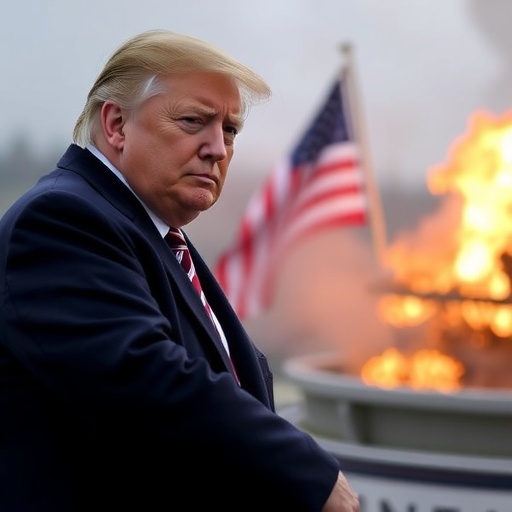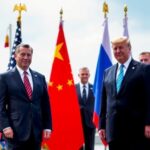Trump Administration Hits Russia’s Rosneft and Lukoil with Severe Oil Sanctions Amid Escalating Ukraine Conflict
In a bold escalation of economic warfare, the Trump administration has unveiled sweeping oil sanctions against Russia’s two largest petroleum giants, Rosneft and Lukoil, directly in response to the intensifying conflict in Ukraine. Announced on Thursday from the White House, these measures come just days after the abrupt cancellation of a highly anticipated summit between President Trump and Russian President Vladimir Putin, signaling a dramatic pivot from diplomatic overtures to unrelenting financial pressure on Russia.
- Targeting Rosneft: The Crown Jewel of Russia’s Energy Empire
- Lukoil’s Global Reach Under Siege from U.S. Oil Sanctions
- Trump’s Diplomatic U-Turn: From Putin Summit to Sanctions Hammer
- Economic Fallout: Shaking Global Markets and Russia’s War Chest
- Path Forward: Escalation Risks and Hopes for Ukraine Resolution
The sanctions, which freeze U.S. assets of the targeted companies and prohibit American firms from engaging in transactions with them, are poised to disrupt billions in global energy trade. Officials estimate that Rosneft, Russia’s state-backed oil behemoth responsible for over 40% of the nation’s crude production, could see its international revenues plummet by up to 30% in the coming months. Lukoil, the country’s second-largest producer, faces similar restrictions that will sever its ties to Western markets, where it derives nearly half its export income.
This move underscores the deepening rift between Washington and Moscow, with Trump himself stating in a press briefing, “Russia‘s aggression in Ukraine cannot go unanswered. These oil sanctions will hit them where it hurts—right in the heart of their economy.” The announcement has already sent shockwaves through energy markets, with Brent crude prices spiking 5% to $85 per barrel in after-hours trading.
Targeting Rosneft: The Crown Jewel of Russia’s Energy Empire
Rosneft, founded in 1993 and partially state-owned since 2004, stands as a cornerstone of Russia‘s economic might, boasting proven reserves exceeding 25 billion barrels of oil equivalent. The company’s sprawling operations span from the Arctic’s harsh frontiers to the vast Siberian fields, producing around 5.5 million barrels per day—enough to fuel the U.S. Midwest for months. Under the new oil sanctions, all U.S. persons and entities are barred from providing financing, goods, or services to Rosneft, effectively isolating it from the dollar-dominated global financial system.
Industry analysts point to Rosneft‘s heavy reliance on Western technology for its upstream exploration as a particular vulnerability. For instance, the company’s $12 billion Vankor field project in Eastern Siberia depends on drilling rigs and seismic imaging tools largely sourced from American firms like Halliburton and Schlumberger. “This is a death knell for Rosneft‘s expansion plans,” noted energy expert Dr. Elena Petrova from the Brookings Institution. “Without access to U.S. capital markets, where they’ve raised over $50 billion in bonds since 2010, they’ll be scrambling to pivot to Asian buyers—at a steep discount.”
Historical context adds layers to this sanction’s bite. Rosneft was first hit with U.S. penalties in 2014 following Russia‘s annexation of Crimea, but those were lighter, focusing on individual executives rather than the corporate entity. The current measures, authorized under the Countering America’s Adversaries Through Sanctions Act (CAATSA), represent a full-throated escalation, potentially costing Rosneft up to $10 billion annually in lost revenues, according to a preliminary report from the U.S. Treasury Department.
Moreover, the sanctions extend to Rosneft‘s joint ventures. Its partnerships with ExxonMobil in the Arctic’s offshore blocks, valued at $15 billion, are now in jeopardy. ExxonMobil has already halted operations in these areas, citing compliance risks, which could leave Rosneft with stranded assets amid thawing ice caps that promised untapped riches.
Lukoil’s Global Reach Under Siege from U.S. Oil Sanctions
While Rosneft dominates headlines as the state flagship, Lukoil—privately held yet deeply intertwined with Russia‘s political elite—faces equally devastating blows. Producing over 2 million barrels per day, Lukoil operates in 18 countries, with significant downstream assets in Europe, including refineries in Bulgaria and Romania that process 500,000 barrels daily. The oil sanctions prohibit any U.S.-linked insurance for Lukoil’s tanker fleet, which transports 1.5 million barrels of crude across the Atlantic and Mediterranean routes.
Lukoil’s CEO, Vagit Alekperov, responded swiftly in a Moscow statement: “These unilateral actions by the Trump administration threaten not just our company but global energy security. We urge our international partners to resist this economic bullying.” The company’s European operations, which account for 25% of its $90 billion annual revenue, are particularly exposed. For example, Lukoil’s stake in Italy’s ISAB refinery, acquired for $2 billion in 2008, relies on U.S. Gulf Coast crude imports; sanctions could force a costly reconfiguration of supply chains.
Statistics from the International Energy Agency (IEA) highlight the broader ripple effects. Russia supplies 10% of Europe’s oil needs, much of it via Lukoil’s pipelines and ports. With these oil sanctions, Europe may see shortages leading to a 15-20% price hike in heating oil this winter, exacerbating inflation in the Eurozone. Domestically, Lukoil employs over 100,000 Russians and contributes 8% to the federal budget through taxes; disruptions could fuel social unrest in oil-dependent regions like the Volga Federal District.
Looking at precedents, Lukoil weathered partial sanctions in 2022 by ramping up sales to India and China, where discounted Urals crude fetched $10 less per barrel than Brent. However, experts warn that the Trump administration’s inclusion of secondary sanctions—penalizing third-party nations that trade with Lukoil—could dry up even these alternative markets, pushing the company toward a precarious pivot to barter deals with sanctioned allies like Iran and Venezuela.
Trump’s Diplomatic U-Turn: From Putin Summit to Sanctions Hammer
The timing of these oil sanctions is no coincidence, arriving mere hours after the White House confirmed the cancellation of a Trump-Putin summit slated for next month in Geneva. Initially billed as a chance for de-escalation in Ukraine, the meeting was derailed by reports of intensified Russian troop buildups along the Donbas border, where over 190,000 soldiers now mass, per NATO intelligence.
President Trump, who once touted his rapport with Putin as a foreign policy asset, framed the shift in stark terms during a Rose Garden address. “I wanted peace, but Russia chose war. Now, they’ll feel the full weight of American resolve through these targeted oil sanctions.” This marks a departure from Trump‘s first-term approach, where he criticized sanctions as counterproductive, even vetoing (unsuccessfully) congressional bills in 2017. Advisors close to the administration whisper that recent intelligence on Russian cyberattacks and election meddling tipped the scales.
The Ukraine conflict provides the urgent backdrop. Since Moscow’s 2022 invasion, over 500,000 troops have clashed, displacing 6 million civilians and destroying infrastructure worth $400 billion, according to UN estimates. Russia‘s oil revenues, which fund 40% of its war machine, have surged to $300 billion yearly despite prior penalties, thanks to shadow fleets evading export caps. The new sanctions aim to cap this windfall by blacklisting 50 Russian-flagged tankers linked to Rosneft and Lukoil.
Internationally, the move aligns with allies. The EU, which imports 25% of its oil from Russia, has pledged parallel measures, including a proposed ban on seaborne crude purchases by year-end. UK Prime Minister Rishi Sunak echoed Trump‘s sentiments: “Solidarity with Ukraine demands we choke off Russia‘s energy lifeline.” Yet, cracks appear; Hungary and Turkey, reliant on discounted Russian supplies, have voiced reservations, potentially complicating enforcement.
Economic Fallout: Shaking Global Markets and Russia’s War Chest
The immediate market reaction to the oil sanctions was visceral. Russia’s RTS Index plunged 7% at open, with Rosneft shares dropping 12% and Lukoil’s 10%, wiping out $20 billion in market cap overnight. Globally, oil futures climbed amid fears of supply disruptions; the IEA warns that if Russia retaliates by curbing exports, world supplies could tighten by 3 million barrels per day, rivaling the 1973 OPEC embargo’s impact.
For Ukraine, the sanctions offer a lifeline. Kyiv, which has lost 20% of its territory and seen GDP contract 30% since the war began, relies on Western aid totaling $100 billion. President Volodymyr Zelenskyy praised the measures in a video address: “Trump‘s decisive action against Rosneft and Lukoil will starve Russia‘s aggression, buying us time to rebuild.” Economists project that sustained pressure could force Moscow to divert $50 billion from military spending to subsidize its oil sector, straining the ruble’s peg and inflating domestic prices by 15%.
Broader implications touch U.S. consumers. With gasoline averaging $3.80 per gallon, analysts from Goldman Sachs forecast a 10-15 cent rise if Russia floods Asia with cheap oil, depressing global prices temporarily before volatility ensues. Renewable energy advocates see opportunity; the sanctions could accelerate Europe’s shift to LNG from Qatar and the U.S., boosting American exports by 20% and creating 50,000 jobs in Texas and Louisiana ports.
Geopolitically, China emerges as a wildcard. As Russia‘s top oil buyer, absorbing 2 million barrels daily from Rosneft, Beijing may stockpile at discounts, offsetting some pain. However, U.S. threats of secondary sanctions on Chinese banks could deter this, forcing a delicate balancing act in Sino-Russian ties.
Path Forward: Escalation Risks and Hopes for Ukraine Resolution
As the dust settles on these oil sanctions, the road ahead bristles with uncertainties. The Trump administration has signaled readiness for further escalation, including potential bans on Russian aluminum and nickel if Ukraine incursions continue. Treasury Secretary Janet Yellen outlined next steps in congressional testimony: “We’ll monitor compliance closely and expand targets if Russia doesn’t withdraw from occupied territories.”
In Moscow, Kremlin’s Dmitry Peskov dismissed the measures as “economic terrorism,” vowing countermeasures like gas cutoffs to Europe. Yet, internal pressures mount; with oil funding 45% of the budget, prolonged isolation could spark elite infighting, echoing the 1998 ruble crisis. For Ukraine, bolstered defenses and incoming F-16 jets from NATO allies offer hope, but experts like Fiona Hill from the Council on Foreign Relations caution: “Sanctions alone won’t end the war—they must pair with diplomatic off-ramps.”
Looking globally, this chapter in U.S.-Russia tensions may redefine energy geopolitics. OPEC+ meetings next week could see Saudi Arabia ramp up output to stabilize prices, while investors flock to green tech, with solar stock indices up 3% post-announcement. Ultimately, the sanctions test Trump‘s legacy: Will they hasten peace in Ukraine, or prolong a grinding stalemate that drains resources on all sides? As winter looms, the world watches, bracing for the chill of economic reprisals.









